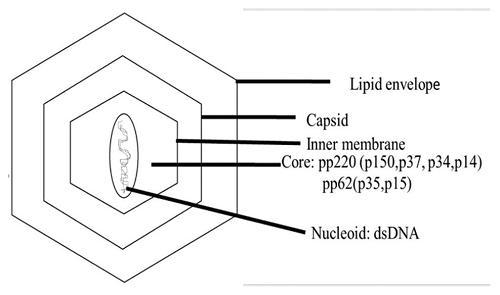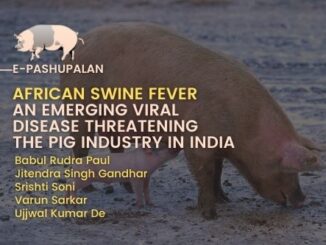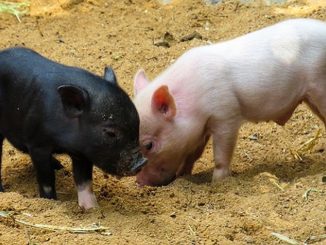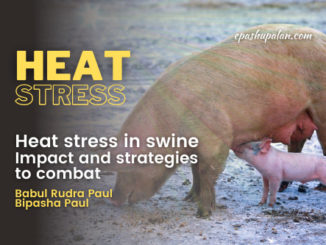Introduction
African swine fever (ASF) is a highly contagious, devastating disease of pigs and wild boars causing severe mortality. ASF is caused by African swine fever virus (ASFV), a genetically complex virus belonging to the genus Asfivirus of family Asfarviridae. OIE has listed ASF as a notifiable disease. The disease was first described in the early 1900’s when the European pig breeds were introduced in Kenya colony and later on disease entered in Europe (Portugal) in 1957 which was controlled quickly, but re-entered Portugal in 1960 and spread to Iberian Peninsula and rest of the Europe. Further, progressing to Russian Federation in 2007 and spread to China in 2018, then to Vietnam and Myanmar and to India.
India has 9 millions of pigs and North eastern (NE) states of India are having more than 45% of Indian pig population mostly reared by economically poor people and pork is their staple food.
Host Range and Transmission
ASFV infects members Suidae family such as domestic and wild boars, feral pigs, bush pigs, warthogs, forest hog, and Ornithodoros ticks (Soft ticks Ornithodoros moubata in Africa and Ornithodoros erraticus in Europe). ASF is non-zoonotic disease. It may be hypothesized that contamination of the habitat by the infected and/ or dead wild pigs in Arunachal Pradesh and Assam or through movement of men and material from the infected habitat might be the possible route of transmission to domestic pigs in India.
Etiology
The causative agent of ASF is ASFV belonging to the genus Asfivirus of the family Asfarviridae.

Epidemiology
The spread and transmission of ASF are unique to each continent of Africa, Europe, and Asia. There are three cycles of ASF epidemiology such as sylvatic, tick–pig, and domestic, with addition of more factors, that is, soft Ornithodoros spp. ticks, wild African pigs (mainly warthogs), domestic pigs, and pig-derived products such as pork.
In the sylvatic cycle, virus is maintained between warthogs and soft ticks, without causing disease in the warthogs. This may be the reason that the virus spilled over to domestic pigs causing disease.
In the tick–pig cycle, ticks act as biological reservoir to maintain the virus and infectious agents gets transmitted among domestic pigs. Such type of cycles was seen in parts of sub-Saharan Africa and also during the epidemic on the Iberian Peninsula in the ‘60s and ‘70s of the past century.
In the domestic cycle, natural reservoirs do not play a role but disease is transmitted in domestic herds from domestic pigs or pig products. The new and fourth cycle of transmission named wild boar-habitat cycle (proposed) reported in some parts of Europe involves Eurasian wild boar, its habitat and their carcasses. This fourth cycle is involving both direct transmissions between wild boar, and indirect transmission through the habitat. Cold and moist climate favors persistency and human movements are the cause of transmission in domestic pigs. Social and economic factors of pig husbandry are also associated with ASF outbreaks in the domestic cycle. The wild boar-habitat cycle is having both direct transmission between infected and susceptible wild boar and indirect transmission through carcasses in the area where wild boar habitat.
Clinical Features
The acute or hyperacute form of African swine fever in susceptible swine is characterized by a severe, hemorrhagic disease with high mortality. Pigs develop fever after an incubation period of 5-15 days. There may be inappetance, incordination and diarrhea. There is dyspnea, vomiting, nasal and conjunctival discharge, reddening or cyanosis of the ears and snout, and hemorrhages from the nose and anus.
Diagnosis
Samples like blood, spleen, kidney, visceral lymph nodes and tonsils are collected for virus isolation, detection of antigen, or polymerase chain reaction (PCR) for detection of the p72 gene. Virus isolation is performed in swine bone marrow or peripheral blood leukocyte cultures. The cytopathic effect is observed after few days of inoculation. After the primary isolation, virus can be grown in other cell lines like Vero cells. Antigen detection is performed by FAT, immunodiffusion, and ELISA.
Immunity, Prevention and Control
Antibody mediated immunity and cell mediated immunity confer protective immunity against ASFV.
Vaccines
At present, there are no vaccines available commercially. Testing of infected and in contact pigs, culling all positive reactors are the only way of preventing the spread of infection, but that eliminates large number of pigs in the locality leading to economic losses to pig farmers. DNA vaccines that contain ASFV genome constructs devoid of CD2v, p54, and p30 have been tried and given limited protection in a population. The development of vaccines against ASF is difficult because of complex nature of virus with its large number of proteins evading host-immune system. Another obstacle in the ASFV propagation is non-availability of a permanent cell lines which can sustain its multiplicity and production in large scale.
Biosafety and Biosecurity Measures
Biosafety at farm level is to be practiced. Persons/ labors handling the infected pigs should take all biosafety precautions such as wearing of protective equipment such as aprons, spectacles, gloves, and gumboots and should not visit the other sheds. Gumboots should be washed with 2% sodium hydroxide immediately after use and various commercial products of disinfectants are available in the market. Biosecurity at farm and village/surrounding regions is to be practiced. Isolation, restriction of movement and sanitation (cleaning and disinfection) has controlled the spread of ASFV. Rapid culling of all infected and in-contact pigs and proper disposal of cadavers, litter, and waste food is essential. All these things should be buried deeply in the vicinity over layered with lime and salt, not to transport to distant places to avoid spillage. Thorough cleaning (with water) of farm/infected area and disinfection (Disinfection may be carried out with 2% sodium or calcium hypochlorite/sodium hydroxide or a detergent-based virucidal agent), if tick population is high, one can use acaricide depending on the need. Farm utensils should be cleaned with detergents and washed properly. Creating awareness among the animal health workers about the disease, training them in early recognition, collection, and dispatch of suspected clinical samples, and intimation to the nearest dispensary are important steps in the field of health-care system.
Conclusion
Based on all the above facts that ASF is a highly contagious disease of pigs and wild boars causing 100% mortality leading to huge economic loss to pig farmers. There is no vaccine available commercially. Affected and in contact pigs are to be culled and buried deep. The infected sheds and premises need to be cleaned and disinfected thoroughly and restocking can be done 4 months later from known source of healthy farms.
References
- Dixon, L.K., Escribano, J.M., Martins, C., Rock, D.L., Salas, M.L. and Wilkinson, P.J. (2005) Asfarviridae. In: Fauquet, C.M., Mayo, M.A., Maniloff, J., Desselberger, U. and Ball, L.A., editors. Virus Taxonomy. 8th Report of the International Committee on Taxonomy of Viruses. Elsevier Academic Press, London. p135-143.
- Terpstra, C. and Wensvoort, G. (1986) African swine fever in the Netherlands. Tijdschr Diergeneeskd, 111(8): 389-392.
- World Organization for Animal Health. (2020a) African Swine Fever (ASF) Report No. 52: August 21-September 03, 2020. World Animal Health Information Department, World Organization for Animal Health, Paris, France.
- Food and Agriculture Organization. (2018) African swine fever threatens Peoples Republic of China. Animal Health Risk Analysis, Assessment No. 5. Food and Agriculture Organization, Rome, Italy.
- Livestock Census. (2019) Department of Animal Husbandry Livestock Census. (2019) Department of Animal Husbandry.
- Costard, S., Mur, L., Lubroth, J., Sanchez-Vizcaino, J.M. and Pfeiffer, D.U. (2013) Epidemiology of African swine fever virus. Virus Res., 173(1): 191-197.
- Penrith, M.L. and Vosloo, W. (2009) Review of African swine fever: Transmission spread and control. J. S. Afr. Vet. Assoc., 80(2): 58-62.






1 Trackback / Pingback